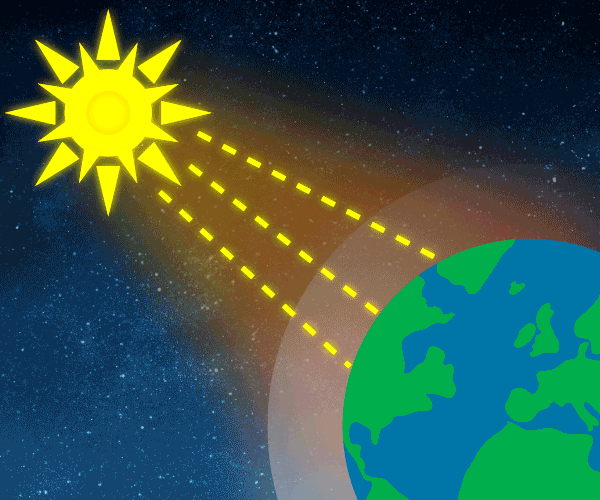1. The Natural greenhouse effect
1. The Natural greenhouse effect
1.1. Science of the natural Greenhouse Effect
Energy from the universe enters our planet, warming land, sea and air. The main source of energy is the sun. The planet warms during daytime, cools during nighttime. To keep the average temperature at the same level, the same amount of energy reaching the Earth, must leave. This is called the “energy balance ” of the Earth.

The amount of energy reaching the top of Earth’s atmosphere each second on a surface area of one square metre facing the Sun during daytime is about 1,370 Watts, and the amount of energy per square metre per second averaged over the entire planet is one-quarter of this: 343 Watts per m2.
About 30% of the sunlight, 103Watts per m2, reaching the top of the atmosphere is reflected back to space. Almost 70% of this reflectivity is due to clouds and particles in the atmosphere, the ‘aerosols’. Light-coloured areas of Earth’s surface such as snow, ice and deserts, reflect the remaining 30% of the sunlight.
Dramatic changes in aerosol reflectivity occur after major volcanic eruptions ejecting aerosols into the stratosphere. Aerosols in the troposphere are cleared by rain in a week or two. However, particles thrown above the troposphere roughly 10 km up in the atmosphere may remain floating in the air for months and years before falling into the troposphere. Volcanic eruptions can cause a drop in mean global surface temperature of about half a degree celsius that can last for several months.
Solar energy not reflected back to space is absorbed by the Earth’s surface and atmosphere. This amount is 240 Watts per square metre (W m–2). To balance the incoming energy, the Earth must radiate the same amount of energy back to space in the form of outgoing longwave, infrared radiation. Everything on Earth emits longwave radiation continuously. To emit 240 W m–2, the Earth’s surface would have to have a temperature of around –19°C; much colder than the conditions that actually exist at the Earth’s surface. The global mean surface temperature is about +14°C.

Graphic: Thomas Andersen, UIA.
The Earth’s surface is this warm due to the greenhouse gases, acting as a “blanket” for the longwave radiation coming from the surface. This blanketing is known as the natural greenhouse effect. The natural greenhouse effect thus makes a difference of almost 33°C.
The enhanced greenhouse effect has so far added almost one extra centigrade coming in addition to the 33°C existing naturemade centigrades.
- From IPCC: What Factors determine Earth’s Climate?
- NASA: The Earth’s energy budget
- Royal Society/climate change: An introduction to climate change in 60 seconds
- Pierrehumbert, R. (2011) Infrared radiation and planetary temperature
- Real Climate.org http://www.realclimate.org/